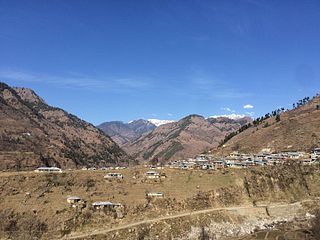
Swat District is a district in Malakand Division of Khyber Pakhtunkhwa province in Pakistan. Centred upon the upper portions of the Swat River, Swat was a major centre of early Buddhist thought as part of the Gandhara kingdom, and today is littered with ruins from that era. Swat was home to the last isolated pockets of Gandharan Buddhism, which lasted until the 10th century, well after most of the area had converted to Islam. Until 1969, Swat was part of the Yusafzai State of Swat, a self-governing princely state. The region was seized by the Pakistani Taliban in late 2007, and its tourist industry decimated until Pakistani control over Swat was re-established in mid 2009.

Shina is a language from the Dardic sub-group of the Indo-Aryan family spoken by the Shina people, a plurality of the people in Gilgit-Baltistan and Chitral of Pakistan and a number of people in Ladakh, India, as well as in pockets in Jammu and Kashmir, India, such as in Gurez.

This is a list of districts of Afghanistan, known as wuleswali. These are secondary level administrative units, one level below the provinces. The Afghan government issued its first district map in 1973. It recognized 325 districts, counting wuleswalis (districts), alaqadaries (sub-districts), and markaz-e-wulaiyat. In the ensuing years additional districts have been added through splits, and a few eliminated through mergers. In June 2005, the Afghan government issued a map of 398 districts. It was widely adopted as by many information management systems, though usually with the addition of Sharak-e-Hayratan for a 399 district total. Here is a link to a clean rendering of the 399 district set as a spreadsheet from an official Afghan source. It remains the de facto standard, as of late 2018, despite a string of government announcements of the creation of new districts.
Kohistan, also transliterated Kuhistan, Kuhiston, Quhistan, may refer to:
Kohistan District may refer to one of the following:

Allai is a tehsil of Batagram District in Pakistan's Khyber-Pakhtunkhwa province. It is home to the Allai Valley.

Torwali is a Dardic language of the Northwestern Indo-Aryan family mainly spoken in the Bahrain and Chail areas of the Swat District in Northern Pakistan. It is said to have originated from the pre-Muslim Dardic communities of Pakistan. It has two dialects, Bahrain and Chail. The language and its community, like other communities, Gawri in Swat and in Dir, and the ones in Indus Kohistan, is often referred to as "Kohistani" which is a name given by the Swat Pashtuns. Fredrik Barth says "By the Swat Pashtuns, the people are known as Kohistanis, together with the other non-Pashtun peoples given that name; together with the Torwalis, Kohistanis of Swat Kohistan". The Afghans call them 'Kohistani'--a name everywhere given by Pashtuns to 'the Musulmans of Indic descent living' in Hindu Kush. Close to 30-35% of its speakers have migrated permanently to the bigger cities of Pakistan where their language is either being replaced by the national language Urdu, or by other languages of wider communication such as Pashto or Punjabi. The language Torwali is said to have originated from the pre-Muslim Dardic communities of Swat.

Kalami (کالامي), also known as Gawri (ګاوری), Garwi, or Bashkarik, is a Dardic language spoken in Swat Kohistan region in the upper Swat District and in the upper Panjkora river valley of Upper Dir District, Khyber Pakhtunkhwa, Pakistan.

Hesa Awal Kohistan District is a new district, created from the bigger Kohistan District in Kapisa Province, Afghanistan. The district center is Kohistan. The population is 60,300 (2006), mostly Tajik.

Indus Kohistani (Kōstāĩ) is a Dardic language spoken in part of the Indus valley in Kohistan District, Khyber Pakhtunkhwa Province, Pakistan. The language was referred to as Maiyã (Mayon) or Shuthun by early researchers, but subsequent observations have not verified that these names are known locally. It is also known as Abasin Kohistani.

Shighnan District is one of the 28 districts of the Badakhshan Province in eastern Afghanistan. It's part of the history region of Shighnan that is today divided between Afghanistan and Tajikistan.The district borders the Panj River and Tajikistan in the northeast, the Maimay district to the west, the Raghistan district in the southwest, the Kohistan, Arghanj Khwa, and Shuhada districts in the south, and the Ishkashim district in the southeast.

Kohistan, also transliterated Kuhistan, Kuhiston, is the northern district of Kapisa province, Afghanistan. In productive agricultural seasons the area has an abundance of sweet mulberries, grapes, apricots and pomegranates. Yearly thousands of visitors spend their weekends in its picnic place of Sayaad along the Panjshir river that flows into Sourubi lake. The population was 100,200 (2006), mainly Persian-speaking Tājik people.
Chilisso is a Dardic language in the Kohistani language group spoken by a thousand people in eastern Kohistan, Pakistan.
SahibzadaMir Masjidi Khan is one of many celebrated Tajik resistance leaders from Shamali Plain who opposed the installation of Shuja Shah Durrani as Emir of Afghanistan by the Government of British India during the First Anglo-Afghan War. He kept up a fierce struggle against the occupation forces in and around Kabul and Northern Afghanistan, until his death.
Gowro, also known as Gabaro, is a Dardic language of the Kohistani group spoken in Kohistan District, Pakistan.
Bateri is a Dardic language of the Kohistani group spoken in Kohistan District, Pakistan and Jammu and Kashmir, India.
Kohistanis are speakers of the Maiyã language, shina language, a member of the Dardic subgroup of the Indo-Aryan language family. They are located in Northern Pakistan.

The Kohistan video case is an honour killing case that took place in May 2012 in Palas Valley, Kohistan, Pakistan. It involved the honour killing of up to five girls, of whom a video had emerged on the internet. The video featured a boy dancing while four girls clapped and sang along.









